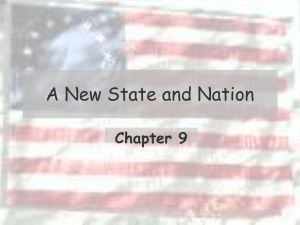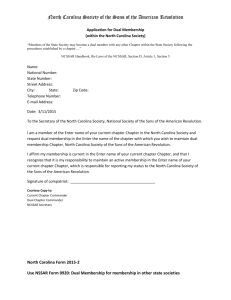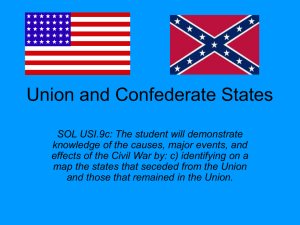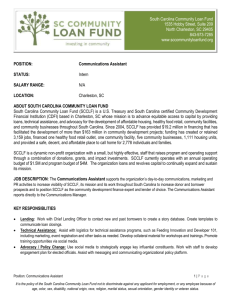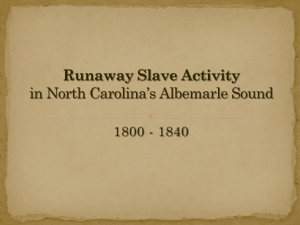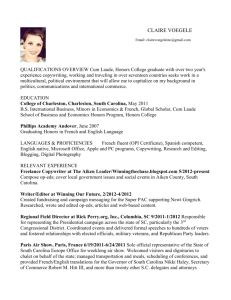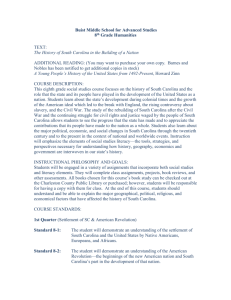5 The Up Country
advertisement
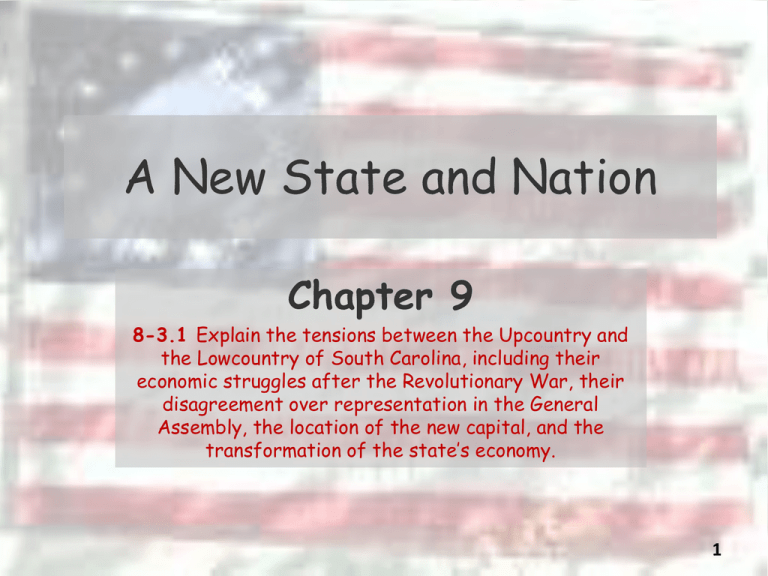
A New State and Nation Chapter 9 8-3.1 Explain the tensions between the Upcountry and the Lowcountry of South Carolina, including their economic struggles after the Revolutionary War, their disagreement over representation in the General Assembly, the location of the new capital, and the transformation of the state’s economy. 1 How did the American Revolution stress the already poor relationship between the Low Country and the Up Country? 2 Up Country vs Low Country The American Revolution Made the already stressed relationship even worse Low Country Patriots fought Up Country Loyalists Sometimes turning neighbors and even family members against each other These tensions continued after the Revolutionary War ended 3 What caused most of the differences between the Low Country and the Up Country? How did the Low Country view the Up Country settlers? 4 Up Country vs Low Country The Economic Differences Caused most of the differences between the Up Country & the Low Country in SC The first white settlers to move to the Up Country were traders and woodsmen They were viewed by the Low Country elite as “uncivilized.” 5 The Up Country “Folk” 6 Up Country vs Low Country Up Country Folk Subsistence farmers who worked the land A few owned slaves, but they did not have large plantations and large slave holdings Many worked their farms without the assistance of slave labor 7 The People of the Low Country 8 Up Country vs Low Country The Low Country The first area settled in the state Dominated by the wealthy planter elite Whose economic well being and social status depended on their slave holdings Eventually, the plantation owners in this area grew wealthy (rich) from the export of rice and indigo. 9 As a result of the American Revolution, what happened to South Carolina’s farms/fields? 10 Economic issues All of South Carolina suffered economically as a result of the war During the war years: Fighting destroyed the countryside Slaves, livestock and goods were taken by the British Fields/farms were also damaged from revenge actions between loyalists and patriots, OR as a result of supporting the armies camped nearby The fields that had grown rice before the war were damaged beyond repair After the War: The economy was slow to improve 11 As a result of the American Revolution… 1. What happened to South Carolina’s slave population? 2. What happened to South Carolina’s cash crop market? 12 Economic issues The slave population Drastically decreased By the end of the war nearly 25,000 slaves had been killed, stolen, or escaped. This made rebuilding the damaged fields and growing new crops extremely difficult. Before the war: the Low Country benefited from England’s subsidies, and Great Britain provided SC a guaranteed rice market After the war: the subsidies were gone Great Britain was lost as a trade partner 13 Poor crop yields: Planters’ debt: 14 Economic issues Poor crop yields •Made it even more difficult to recover economically •When you don’t have a lot of crops to sell, you don’t get a lot of money to repay debt. •The planters owed money to creditors in England •Which they had borrowed before the war and they could not pay it back because they weren’t making money off of their crops. 15 Commandeered goods: 16 Economic issues During the war the Armies from both side took food and property from the local people. Commandeered goods Property that was lost to either army and not repaid/replaced 17 What plant helped South Carolina recover economically when it became a cash crop in the 1800s? 18 Economic issues The American Government Was also unable to pay for the goods it had commandeered during the fighting from the citizens of the state Economic problems persisted until the early 1800s when cotton became a new cash crop. 19 For what 3 reasons did the Low Country have a greater influence on the SC government? 20 Economic issues South Carolina’s early years There was a larger white population living in the Up Country 1. Most of the political power rested in the Low Country 2. The Low Country had greater representation in the legislature 3. Charleston was the capital – Which gave the Charleston elite a greater influence on the government 21 What was a major complaint that the Up Country had about having the state capital in Charleston? To where was the capital moved? What did the Low Country get to keep in the compromise to move the capital? 22 Economic issues Up Country people didn’t like having to travel so far to present issues to the legislature. In 1786, the Low Country compromised and the capital was moved to the newly established city of Columbia. It was in the center of the state and equally accessible to both regions As a compromise for moving the capital, the Low Country maintained its majority in the legislature. 23 Economic issues This helped ease but did not eliminate political tensions between the Up Country and the Low Country. 24
